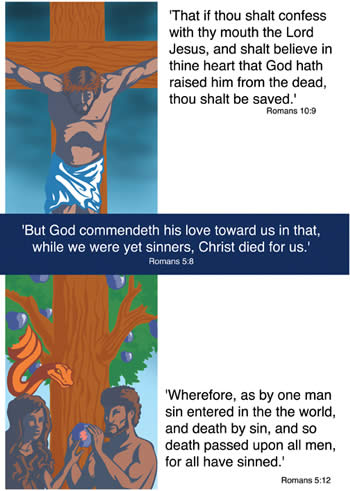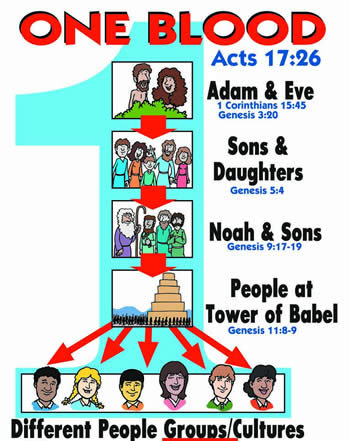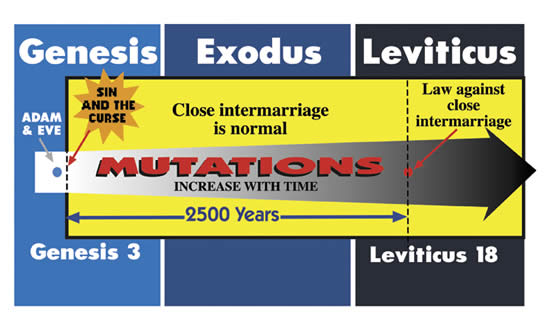Defenders of the gospel must be able to show that all human beings are descendants of one man and one woman
Is She the Most-Talked-About Wife in History?
We don’t even know her name, yet she was discussed at the Scopes Trial, mentioned in the movies Inherit the Wind1 and Contact,2 and talked about in countries all over the world for hundreds of years.
Skeptics of the Bible have used Cain’s wife time and again to try to discredit the book of Genesis as a true historical record. Sadly, most Christians have not given an adequate answer to this question. As a result, the world sees them as not being able to defend the authority of Scripture and thus the Christian faith.
For instance, at the historic Scopes Trial in Tennessee in 1925, William Jennings Bryan, the prosecutor who stood for the Christian faith, failed to answer the question about Cain’s wife posed by the ACLU lawyer Clarence Darrow. Consider the following excerpt from the trial record as Darrow interrogates Bryan:
Q—Did you ever discover where Cain got his wife?
A—No, sir; I leave the agnostics to hunt for her.
Q—You have never found out?
A—I have never tried to find.
Q—You have never tried to find?
A—No.
Q—The Bible says he got one doesn’t it? Were there other people on the earth at that time?
A—I cannot say.
Q—You cannot say. Did that ever enter your consideration?
A—Never bothered me.
Q—There were no others recorded, but Cain got a wife.
A—That is what the Bible says.
Q—Where she came from you do not know.3
The world’s press was focused on this trial, and what they heard has affected Christianity to this day—Christians can’t defend the biblical record!
In recent times, this same example was taken up by Carl Sagan in his book Contact2 (which was on the New York Times best-seller list) and used in the movie of the same name based upon this work.
In the book, we read the fictional character Ellie’s account of how she could not get answers from a minister’s wife, who was the leader of a church discussion group:
Ellie had never seriously read the Bible before ... . So over the weekend preceding her first class, she read through what seemed to be the important parts of the Old Testament, trying to keep an open mind. She at once recognized that there were two different and mutually contradictory stories of Creation ... and had trouble figuring out exactly who it was that Cain had married.4
Sagan cleverly listed a number of common questions (including Cain’s wife) that are often directed at Christians in an attempt to supposedly prove the Bible is full of contradictions and can’t be defended. The truth is—most Christians probably couldn’t answer these questions. And yet there are answers. But since churches lack in the teaching of apologetics,5 particularly in regard to the book of Genesis, most believers in the church are not able to “always be ready to give a defense to everyone who asks you a reason for the hope that is in you, with meekness and fear” (1 Peter 3:15).
Why Is It Important?
Many skeptics have claimed that for Cain to find a wife, there must have been other “races” of people on the earth who were not descendants of Adam and Eve. To many people, this question is a stumbling block to accepting the creation account of Genesis and its record of only one man and woman at the beginning of history. Defenders of the gospel must be able to show that all human beings are descendants of one man and one woman (Adam and Eve) because only descendants of Adam and Eve can be saved. Thus, believers need to be able to account for Cain’s wife and show clearly she was a descendant of Adam and Eve.
In order to answer this question of where Cain got his wife, we first need to cover some background information concerning the meaning of the gospel.
The First Man
“Wherefore, as by one man sin entered into the world, and death by sin; and so death passed upon all men, for that all have sinned” (Romans 5:12).
We read in 1 Corinthians 15:45 that Adam was “the first man.” God did not start by making a race of men.

The Bible makes it clear that only the descendants of Adam can be saved. Romans 5 teaches that we sin because Adam sinned. The death penalty, which Adam received as judgment for his sin of rebellion, has also been passed on to all his descendants.
Since Adam was the head of the human race, when he fell we who were in the loins of Adam fell also. Thus, we are all separated from God. The final consequence of sin would be separation from God in our sinful state forever. However, the good news is that there is a way for us to return to God.
Because a man brought sin and death into the world, the human race, who are all descendants of Adam, needed a sinless Man to pay the penalty for sin and the resulting judgment of death. However, the Bible teaches that “all have sinned” (Romans 3:23). What was the solution?
The Last Adam
God provided the solution—a way to deliver man from his wretched state. Paul explains in 1 Corinthians 15 that God provided another Adam. The Son of God became a man—a perfect Man—yet still our relation. He is called “the last Adam” (1 Corinthians 15:45) because he took the place of the first Adam. He became the new head and, because He was sinless, was able to pay the penalty for sin:
For since by [a] man came death, by [a] Man also came the resurrection of the dead. For as in Adam all die, even so in Christ all shall be made alive (1 Corinthians 15:21–22).
Christ suffered death (the penalty for sin) on the Cross, shedding His blood (“and without shedding of blood there is no remission,” Hebrews 9:22) so that those who put their trust in His work on the Cross can come in repentance of their sin of rebellion (in Adam) and be reconciled to God.
Thus, only descendants of the first man Adam can be saved.
All Related

Since the Bible describes all human beings as sinners, and we are all related (“And He has made from one blood every nation of men to dwell on all the face of the earth,” Acts 17:26), the gospel makes sense only on the basis that all humans alive and all that have ever lived (except for the first woman6 ) are descendants of the first man Adam. If this were not so, then the gospel could not be explained or defended.
Thus, there was only one man at the beginning—made from the dust of the earth (Genesis 2:7).
This also means that Cain’s wife was a descendant of Adam. She couldn’t have come from another race of people and must be accounted for from Adam’s descendants.
The First Woman
In Genesis 3:20 we read, “And Adam called his wife’s name Eve, because she was the mother of all living.” In other words, all people other than Adam are descendants of Eve—she was the first woman.
Eve was made from Adam’s side (Genesis 2:21–24)—this was a unique event. In the New Testament, Jesus (Matthew 19:4-6) and Paul (Ephesians 5:31) use this historical and onetime event as the foundation for the marriage of one man and one woman.
Also, in Genesis 2:20, we are told that when Adam looked at the animals, he couldn’t find a mate—there was no one of his kind.
All this makes it obvious that there was only one woman, Adam’s wife, from the beginning. There could not have been a “race” of women.
Thus, if Christians cannot defend that all humans, including Cain’s wife, can trace their ancestry ultimately to Adam and Eve, then how can they understand and explain the gospel? How can they justify sending missionaries to every tribe and nation? Therefore, one needs to be able to explain Cain’s wife, to illustrate that Christians can defend the gospel and all that it teaches.

Who Was Cain?
Cain was the first child of Adam and Eve recorded in Scripture (Genesis 4:1). He and his brothers, Abel (Genesis 4:2) and Seth (Genesis 4:25), were part of the first generation of children ever born on this earth. Even though these three males are specifically mentioned, Adam and Eve had other children.
Cain’s Brothers and Sisters
In Genesis 5:4 we read a statement that sums up the life of Adam and Eve: “After he begot Seth, the days of Adam were eight hundred years; and he had sons and daughters.”
During their lives, Adam and Eve had a number of male and female children. In fact, the Jewish historian Josephus wrote, “The number of Adam’s children, as says the old tradition, was thirty-three sons and twenty-three daughters.”7
Scripture doesn’t tell us how many children were born to Adam and Eve, but considering their long life spans (Adam lived for 930 years—Genesis 5:5), it would seem logical to suggest there were many. Remember, they were commanded to “be fruitful, and multiply” (Genesis 1:28).
The Wife
If we now work totally from Scripture, without any personal prejudices or other extrabiblical ideas, then back at the beginning, when there was only the first generation, brothers would have had to marry sisters or there wouldn’t have been any more generations!
We’re not told when Cain married or many of the details of other marriages and children, but we can say for certain that Cain’s wife was either his sister or a close relative.
A closer look at the Hebrew word for “wife” in Genesis reveals something readers may miss in translation. It was more obvious to those speaking Hebrew that Cain’s wife was likely his sister. (There is a slim possibility that she was his niece, but either way, a brother and sister would have married in the beginning.) The Hebrew word for “wife” used in Genesis 4:17 (the first mention of Cain’s wife) is ishshah, and it means “woman/wife/female.”
And Cain knew his wife [ishshah], and she conceived and bore Enoch. And he built a city, and called the name of the city after the name of his son—Enoch (Genesis 4:17).
The word ishshah is the word for “woman,” and it means “from man.” It is a derivation of the Hebrew words ‘iysh (pronounced: eesh) and enowsh, which both mean “man.” This can be seen in Genesis 2:23 where the name “woman” (ishshah) is given to one who came from Adam.
And Adam said: “This is now bone of my bones and flesh of my flesh; She shall be called Woman [ishshah], because she was taken out of Man [iysh]” (Genesis 2:23).
Thus, Cain’s wife is a descendant of Adam/man. Therefore, she had to be his sister (or possibly niece). Hebrew readers should be able to make this connection easier; however, much is lost when translated.
Objections
God’s Laws
Many people immediately reject the conclusion that Adam and Eve’s sons and daughters married each other by appealing to the law against brother-sister marriage. Some say that you can’t marry your relation. Actually, if you don’t marry your relation, you don’t marry a human! A wife is related to her husband before they are married because all people are descendants of Adam and Eve—all are of one blood. This law forbidding close relatives marrying was not given until the time of Moses (Leviticus 18–20). Provided marriage was one man for one woman for life (based on Genesis 1–2), there was no disobedience to God’s law originally (before the time of Moses) when close relatives (even brothers and sisters) married each other.
Remember that Abraham was married to his half-sister (Genesis 20:12).8 God’s law forbade such marriages,9 but that was some four hundred years later at the time of Moses.
Biological Deformities
Today, brothers and sisters (and half-brothers and half-sisters, etc.) are not currently permitted by law to marry and have children.
Now it is true that children produced in a union between brother and sister have a greater chance to be deformed. As a matter of fact, the closer the couple are in relationship, the more likely it is that any offspring will be deformed. It is very easy to understand this without going into all the technical details.
Each person inherits a set of genes from his or her mother and father. Unfortunately, genes today contain many mistakes (because of sin and the Curse), and these mistakes show up in a variety of ways. For instance, people let their hair grow over their ears to hide the fact that one ear is lower than the other. Or perhaps someone’s nose is not quite in the middle of his or her face, or someone’s jaw is a little out of shape. Let’s face it, the main reason we call each other normal is because of our common agreement to do so!
The more closely related two people are, the more likely it is that they will have similar mistakes in their genes, inherited from the same parents. Therefore, brother and sister are likely to have similar mistakes in their genetic material. If there were to be a union between these two that produces offspring, children would inherit one set of genes from each of their parents. Because the genes probably have similar mistakes, the mistakes pair together and result in deformities in the children.
Conversely, the further away the parents are in relationship to each other, the more likely it is that they will have different mistakes in their genes. Children, inheriting one set of genes from each parent, are likely to end up with some of the pairs of genes containing only one bad gene in each pair. The good gene tends to override the bad so that a deformity (a serious one, anyway) does not occur. Instead of having totally deformed ears, for instance, a person may have only crooked ones. (Overall, though, the human race is slowly degenerating as mistakes accumulate generation after generation.)
However, this fact of present-day life did not apply to Adam and Eve. When the first two people were created, they were perfect. Everything God made was “very good” (Genesis 1:31). That means their genes were perfect—no mistakes. But when sin entered the world because of Adam (Genesis 3:6), God cursed the world so that the perfect creation then began to degenerate, that is, suffer death and decay (Romans 8:22). Over a long period of time, this degeneration would have resulted in all sorts of mistakes occurring in the genetic material of living things.

But Cain was in the first generation of children ever born. He, as well as his brothers and sisters, would have received virtually no imperfect genes from Adam or Eve, since the effects of sin and the Curse would have been minimal to start with. In that situation, brother and sister could have married (provided it was one man for one woman, which is what marriage is all about, Matthew 19:4–6) without any potential to produce deformed offspring.
By the time of Moses (about 2,500 years later), degenerative mistakes would have accumulated to such an extent in the human race that it would have been necessary for God to bring in the laws forbidding brother-sister (and close relative) marriage (Leviticus 18–20).10
(Also, there were plenty of people on the earth by now, and there was no reason for close relations to marry.)
In all, there appear to be three interrelated reasons for the introduction of laws forbidding close intermarriage:
- As we have already discussed, there was the need to protect against the increasing potential to produce deformed offspring.
- God’s laws were instrumental in keeping the Jewish nation strong, healthy, and within the purposes of God.
- These laws were a means of protecting the individual, the family structure, and society at large. The psychological damage caused by incestuous relationships should not be minimized.
Cain and the Land of Nod
Some claim that the passage in Genesis 4:16–17 means that Cain went to the land of Nod and found a wife. Thus, they conclude there must have been another race of people on the earth who were not descendants of Adam, who produced Cain’s wife.
Then Cain went out from the presence of the LORD and dwelt in the land of Nod on the east of Eden. And Cain knew his wife, and she conceived and bore Enoch. And he built a city, and called the name of the city after the name of his son—Enoch.
From what has been stated above, it is clear that all humans, Cain’s wife included, are descendants of Adam. However, this passage does not say that Cain went to the land of Nod and found a wife. John Calvin in commenting on these verses states:
From the context we may gather that Cain, before he slew his brother, had married a wife; otherwise Moses would now have related something respecting his marriage.11
Cain was married before he went to the land of Nod. He didn’t find a wife there but “knew” (had sexual relations with) his wife.12
This makes sense in light of what Nod is, too. Nod means “wandering” in Hebrew. So when Cain went to the land of Nod, he was literally going to the land of wandering, not a place full of people.
Who Was Cain Fearful of (Genesis 4:14)?
Some claim that there had to be lots of people on the earth other than Adam and Eve’s descendants; otherwise Cain wouldn’t have been fearful of people wanting to slay him because he killed Abel.
First of all, one reason that someone would want to harm Cain for killing Abel is if that person was a close relation of Abel!
Secondly, Cain and Abel were born quite some time before the event of Abel’s death. Genesis 4:3 states:
And in the process of time it came to pass that Cain brought an offering of the fruit of the ground to the LORD.
Note the phrase “in the process of time.” We know Seth was born when Adam was 130 years old (Genesis 5:3), and Eve saw him as a replacement for Abel (Genesis 4:25). Therefore, the time period from Cain’s birth to Abel’s death may have been 100 years or more—allowing plenty of time for other children of Adam and Eve to marry and have children. By the time Abel was killed, there may have been a considerable number of descendants of Adam and Eve involving several generations.
Where Did the Technology Come From?
Some claim that for Cain to go to the land of Nod and build a city, he would have required a lot of technology that must have already been in that land, presumably developed by other races.
Adam and Eve’s descendants were very intelligent people. We are told that Jubal made musical instruments, such as the harp and organ (Genesis 4:21), and Tubal-cain worked with brass and iron (Genesis 4:22).
Because of intense evolutionary indoctrination, many people today have the idea that their generation is the most advanced that has ever been on this planet. Just because we have jet airplanes and computers doesn’t mean we are the most intelligent or advanced. This modern technology is really a result of the accumulation of knowledge.
We must remember that our brains have suffered from 6,000 years of the Curse. We have greatly degenerated compared to people many generations ago. We may be nowhere near as intelligent or inventive as Adam and Eve’s children. Scripture gives us a glimpse of what appears to be advanced technology almost from the beginning.
Cain had the knowledge and talent to know how to build a city!
Conclusion
One of the reasons many Christians cannot answer the question about Cain’s wife is that they tend to look at today’s world and the problems that would be associated with close relations marrying, and they do not look at the clear historical record God has given to us.
They try to interpret Genesis from our present situation rather than understand the true biblical history of the world and the changes that have occurred because of sin. Because they are not building their worldview on Scripture but taking a secular way of thinking to the Bible, they are blinded to the simple answers.
Genesis is the record of the God who was there as history happened. It is the Word of One who knows everything and who is a reliable Witness from the past. Thus, when we use Genesis as a basis for understanding history, we can make sense of evidence which would otherwise be a real mystery. You see, if evolution is true, science has an even bigger problem than Cain’s wife to explain—namely, how could man ever evolve by mutations (mistakes) in the first place, since that process would have made everyone’s children deformed? The mere fact that people can produce offspring that are not largely deformed is a testimony to creation, not evolution.
Footnotes
- This is a Hollywood version of the famous Scopes Trial. K. Ham, The wrong way round! Creation 8(3):38-41, 1996; D. Menton, Inherit the Wind: an historical analysis, Creation 19(1):35-38, 1997.
- Contact, Warner Bros., released July 11, 1997. Based on Carl Sagan’s Contact, Pocket Books, New York, 1985.
- The World’s Most Famous Court Trial, Tennessee Evolution Case (a word-for-word report), Bryan College (reprinted from the original edition), p. 302, 1990.
- C. Sagan, Contact, Pocket Books, New York, 1985, 19–20.
- Apologetics—from the Greek word, απολογια (apologia), meaning “to give a defense.” The field of Christian apologetics covers the ability of Christians to give a defense of their faith in Jesus Christ and their hope in Him for salvation, as expressed in 1 Peter 3:15. This ability requires a thorough knowledge of Scripture, including the doctrines of the creation, Original Sin, Curse, Flood, Virgin Birth, life and ministry of Jesus of Nazareth, the Cross, Crucifixion, Resurrection, Ascension, promise of the Second Coming, and a new heaven and new earth. Then one needs to be able to explain logically and clearly these various doctrines in a way that justifies one’s faith and hope in Jesus Christ.
- Eve, in a sense, was a descendant of Adam in that she was made from his flesh and thus had a direct biological connection to him (Genesis 2:21–23).
- F. Josephus, The Complete Works of Josephus, translated by W. Whiston, Kregel Publications, Grand Rapids, Michigan, 1981, 27.
- Another example would be Isaac’s wife, Rebekah—she was Isaac’s second cousin (Genesis 24:15).
- Leviticus 18–20.
- Some have claimed this means God changed His mind by changing the laws. But God didn’t change His mind—because of the changes that sin brought and because God never changes, He introduced new laws for our sake.
- J. Calvin, Commentaries on The First Book of Moses Called Genesis, Vol. 1, reprinted, Baker House, Grand Rapids, Michigan, 1979, 215.
- Even if Calvin’s suggestion concerning this matter is not correct, there was still plenty of time for numerous descendants of Adam and Eve to move out and settle areas such as the land of Nod.